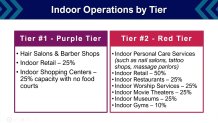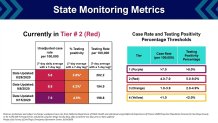San Diego will stay in the red tier, for now, the state confirmed Tuesday during its weekly update. The county's adjusted case rate was 6.9 cases per 100,000 residents, just under the 7.0 threshold that would have shifted the county back into the more-restrictive purple tier.
Due to an increase in COVID-19 cases in the region, in part due to nearly 900 San Diego State University students testing positive, small businesses were bracing themselves for whiplash that never came.
The rate was 7.9 the previous week, putting the county on warning that it was on the brink of reversing course. The county's percentage of positive test rates was 3.8%, staying well below the 8% rate that would require closures.
Dr. Mark Ghaly, secretary of the California Health and Human Services Agency, said San Diego has worked hard on contact tracing and testing, and that authorities were still trying to understand the reasons for a jump in its case rate earlier this month. He noted the outbreak at SDSU.
“These are going to be ongoing conversations to understand where a county is,” Ghaly said.
Local
California has seen recent success with the virus, but the campus outbreak threatened to put San Diego over a state threshold for cases that mandate many businesses close or restrict indoor operations.
“Working hard with San Diego to figure out how we can support and look at the numbers so we make that decision in the wisest way we possibly can with both the public health of the San Diego community in mind but also in the broadest way, not just COVID health but the broad economic health,” Ghaly said.
Ghaly said he expects that, someday, a county will likely be moved into a more restrictive tier but added that the state will be very careful about undertaking such a move.
“We don’t yet have enough evidence that it can be attributed to the businesses that have already begun to increase their operations in San Diego," Ghaly said. "Although we’re closely looking at that and that’s where the disease investigation and the contact tracing work, which San Diego is doing an excellent job on, is really useful, so this will be a busy week for San Diego in conversations about how we plan on moving forward.”
Ghaly said steps may be put in place to help San Diego.
For some in the county, it would have marked the third closure since California instituted the nation's first statewide shutdown order in March.
"I can't tell you how excited we are," said Fit Athletic area group fitness director Connie Cook. "We have been crossing our fingers and doing everything we can to stay in this red tier. Now, I think the question is, 'What do we do to move forward?' "
It has been a dizzying turn of events for the county of 3.3 million residents that less than a month ago was the only one in Southern California with virus case numbers low enough to advance to a second level in the state's four-tiered system for reopening.
As part of California’s new tiered metric system, businesses are allowed to offer indoor services, but must follow strict capacities depending on what tier their respective county is in. San Diego County is currently in Tier 2, which is known as the red tier, and allows for minimal indoor services.
Get top local stories in San Diego delivered to you every morning. Sign up for NBC San Diego's News Headlines newsletter.
The tier has been a lifeline for small businesses that have been hanging on by a thread due to the closures brought upon the coronavirus pandemic. However, an uptick in local virus cases threatened to bestow the purple tier onto the region, and it comes with tighter restrictions.
“We do empathize completely with the concern of the business owners and the idea of opening up a couple weeks ago just to close back down, and that’s exactly why these conversations are so important between the state and the county leadership,” Ghaly said on Tuesday.
This is what the purple tier, formally known as Tier 1, would have meant for the county:
- Indoor retailers can operate at 25%
- Indoor shopping centers can operate at 25% capacity with no food courts
- Hair salons and barbershops can operate with modifications, like opening outdoors
- Restaurants can offer takeout, delivery or outdoor dining
- Most non-essential indoor businesses are closed

The color-coded system was introduced by Gov. Gavin Newsom last month as an effort to gradually reopen counties depending on their state-calculated case rate. Any region with a case rate that exceeds 7.0 cases per 100,000 residents would likely be moved or stay in the purple tier.
In response to what were possible closures, local business owners banded together and announced their intentions to defy public health orders if restrictions had been restored. On Monday, Supervisor Jim Desmond joined small business owners in a rally urging county leaders to take local control of reopening the region.

Meanwhile, Supervisor Nathan Fletcher held a press conference Monday and urged residents to unite and follow public health orders to overcome the virus and decrease cases.
"The numbers say we're in red, we’re in red, and that’s encouraging, but we have to continue to be very vigilant because my concern was at the end of August, we opened too many things too fast, and I worry that impact could cause rising cases in the future," Fletcher. "The only chance of avoiding it is extreme vigilance."
The San Diego County Board of Supervisors met behind closed doors last week and on Monday to discuss the possibility of suing the state to prevent being moved into Tier 1. That decision is now moot, for now.



